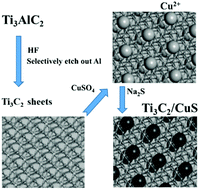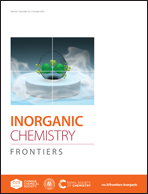Anchoring CuS nanoparticles on accordion-like Ti3C2 as high electrocatalytic activity counter electrodes for QDSSCs†
Abstract
A Ti3C2/CuS composite has been fabricated as a counter electrode for quantum dot-sensitized solar cells by anchoring CuS nanoparticles on Ti3C2via a facile ion-exchange method at room temperature. The accordion-like Ti3C2 is well intercalated and coated with CuS nanoparticles at the optimized ratio of Ti3C2 to CuS. Both electrochemical impedance spectroscopy and Tafel polarization measurements indicate that the composite exhibits a significantly faster electrocatalytic rate towards the polysulfide reduction than pure CuS. The quantum dot-sensitized solar cell-based composite counter electrode displays an overall power conversion efficiency of 5.11% which is 1.5 times that obtained from the CuS counter electrode. The higher power conversion efficiency benefits from the improved short-circuit current density (20.86 mA cm−2), open-circuit voltage (0.56 V) and fill factor (0.45). The enhancement of photovoltaic performance is mainly attributed to the combined advantages of the excellent conductivity of the Ti3C2 skeleton and the abundant catalytically active sites of CuS nanoparticles.



 Please wait while we load your content...
Please wait while we load your content...